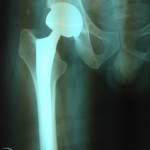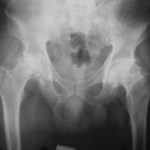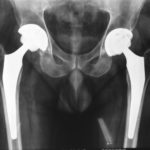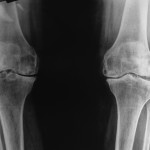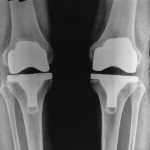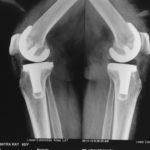Joint Replacement or Replacement Arthroplasty is a surgical process where a joint damaged by trauma or arthritis is surgically replaced with an orthopaedic prosthesis. The goal is to relieve pain and restore normal function and sense into the damaged joint. Joints can be damaged by arthritis and other diseases, injuries, or other causes. Osteorthritis or simply years of use may cause the joint to wear away. This can cause pain, stiffness, and swelling.
The most successful form of arthroplasty these days is the surgical replacement of a joint or joint surface with prosthesis. For example, a hip joint that is affected by osteoarthritis may be replaced entirely (total hip arthroplasty) with a prosthetic hip. This procedure involves replacing both the acetabulum (hip socket) and the head and neck of the femur. The purpose of doing this surgery is to relieve pain, to restore range of motion and to improve walking ability, leading to the improvement of muscle strength.
WHO IS IT FOR?
Joint replacement is considered as a treatment when there is severe joint pain or dysfunction is not alleviated by less-invasive therapies.
CAUSES OF JOINT PAIN
Osteoarthritis
Osteoarthritis (OA), a degenerative joint disease (DJD), is a progressive disorder of the joints caused by gradual loss of cartilage (covering of the joint) and resulting in the development of bony spurs and cysts at the margins of the joints. The name osteoarthritis comes from three Greek words meaning bone, joint, and inflammation. It affects many adults over 50, but severity varies. Knees are the most commonly affected but almost any joint can be. Symptoms are in the form of pain, stiffness, limitation of movement and gradual reduction in speed at which one can walk. Limp and deformity is also often seen.
OA is usually managed by controlling weight and modifying lifestyle. Exercise in the form of walking and cycling are beneficial. Avoid sitting cross-legged on the floor but patients can use the staircase. Medicines do help but only at an early stage. Late stages usually require surgery in the form of osteotomy (re-alignment of joint) or joint replacement.
Rheumatoid Arthritis
Rheumatoid arthritis (RA) is a chronic autoimmune disease that causes inflammation and deformity of the joints. Other problems throughout the body (systemic problems) may also develop, including inflammation of blood vessels, the development of bumps (called rheumatoid nodules) in various parts of the body, lung disease, blood disorders, and weakening of the bones (osteoporosis). Modern drugs have revolutionized treatment of rheumatoid arthritis. Some patients do still end up having surgery – usually in the form of joint replacement of the knees, hips, shoulders and elbow.
Gout
This is a form of arthritis that can affect any joint but most commonly the big toe. The attacks are usually sudden and are very painful. Gout is due to high blood levels of uric acid. For those who suffer from gout, avoid eating fatty foods, red meats such as mutton, beef and vegetables such as spinach (palak). Avoid getting dehydrated and limit alcohol consumption especially beer. Sometimes medicines may have to be taken long term.
Avascular necrosis
This disorder generally affects the hip joint and is due to loss of blood supply to the bone. Some of the causes include: injury to the hip joint, steroid use, excessive alcohol use and certain conditions like sickle cell anemia. Symptoms start with mild pain but gradually progress to more severe continuous pain that interferes with most activities of daily living. Eventually, as the bone collapses, the leg can shorten and the joint can deform leading to severe limitation of walking and a marked limp leading.
Early stages can be managed by certain medicines but eventually most people would require surgery. Surgical treatment includes: core decompression +/- bone graft, osteotomy or re-alignment of the joint and finally joint replacement.
Ankylosing Spondylitis
This condition usually affects young men and can cause stiffness of the hip and spine. Other joints may also be affected. Occasionally the hip joints can fuse and all movement at that joint stops. Similarly, the spine can become rigid and deformed. Medicines do help if started early and exercise is essential to prevent deformity and rigidity. Surgery of the spine and hip joint replacement is sometimes required.
Injury
Injury around joints can cause severe wear or destruction of the joint. Mobility can be severely restricted and painful. Eventually a joint replacement may become necessary.
UDAI OMNI: FOREMOST IN JOINT REPLACEMENT
Joint replacement is an area of excellence at UDAI OMNI Clinic and the specialists are recognised for their expertise in the joint replacement techniques for knee and hip joints.
UDAI OMNI specialist, Dr. Udai Prakash, regularly performs Total Hip Replacement, Hip Resurfacing, Total Knee Replacement, Unicondylar (partial) Knee Replacement, Revision Hip and Knee Replacement, and Minimally Invasive Joint Replacement Surgery.
TOTAL HIP REPLACEMENT IN AVASCULAR NECROSIS
Mr AM, 40 years, was suffering with pain in both his hips due to avascular necrosis. For years he was avoiding surgery thinking it would not be successful as he had heard “stories” from his friends and relatives. However, when pain became unbearable he agreed to have both his hips replaced. As you can see from the video, a year later, he leads a normal life.
MRS. MR, 62 YEARS, BILATERAL TOTAL KNEE REPLACEMENT
narrowing of the joint
space before surgery
post-surgery
At 62, Mrs CK wanted to be very active but her knees were not letting her do even everyday things like shopping and walking more than a couple of hundred yards. Even her sleep was getting disturbed due to severe osteoarthritis of her knees.
She was referred to us by other happy patients from Kolkata and she flew all the way to Hyderabad for bilateral total knee replacement. Within 3 months she was walking unlimited distance and shopping to her heart’s content. As you can see from the video taken at 3 months post-operatively she barely has a limp.
TOTAL KNEE REPLACEMENT
This 65 year old gentleman was suffering from quite severe pain in his knee which interfered with almost all his daily activities including sleep at night. He was constantly taking painkillers to get by. Examination showed deformity of his knee with a limited range of movement. X-ray confirmed severe arthritis with almost complete loss of joint space in two out of the three compartments of the knee. A total knee replacement corrected the deformity and relieved the pain. By 3 months he had cut down his painkillers to the odd one perhaps once a week.
PRIMARY BILATERAL (BOTH SIDES AT THE SAME TIME) HIP REPLACEMENT – UNCEMENTED
A 42 year old lady presented with pain in her hips for over 2 years. For the last 3 months she could hardly walk and was moving around in a wheelchair. She was depressed and had lost over 20 kilos in weight. She lost her job and was literally in tears in the clinic. An x-ray of her pelvis showed that both her hips were destroyed due to rapidly progressive osteoarthritis. This is a rare condition when the hips fail for unknown reasons. She was admitted as an emergency a few days later with intractable pain.
She underwent complex hip replacement surgery of both her hips using un cemented prosthesis. She did extremely well and was discharged within 7 days. She was able to walk with crutches. By six weeks she was walking independently without an aid and had put on 10 kilos in weight. At 2 years, she continues to do well and has taken up Salsa dancing and has put all her weight back on and has got a job as a teacher.
COMPLEX PRIMARY HIP REPLACEMENT WITH BONE GRAFTING
A 65 year old lady came to us with severe pain in her left hip which developed rapidly over the last six months. She also noticed significant shortening of her left leg and noticed that her foot was pointing outwards as she walked. X-ray of her hip showed that the socket of the hip joint had weakened to such an extent that the ball of the joint was protruding into the pelvis. Urgent surgery was undertaken and bone from the ball of the hip was crushed and used as a graft to build up the socket. A cemented hip replacement was done. She did extremely well postoperatively and at 3 years, remains delighted with the outcome. He leg length was restored with surgery and her foot progression angle is also now normal.
PRIMARY HIP REPLACEMENT – CEMENTED
A 70 year old lady presented to us with increasing pain in her left hip over 2 years. The pain was interfering with her daily activities like walking, standing up from a chair, getting in and out of a bath, putting on her shoes etc. It also started to wake her up at night on a regular basis. She had tried many the pain killers with minimal benefit.
On clinical examination, she clearly walked with a limp and appeared to be in considerable pain. Her hip was stiff and all movements caused severe pain. An X-ray clearly showed severe osteoarthritis affecting her right hip. She underwent a cemented hip. At six weeks she was pain free. Five years later, she remains pain free and is delighted with the result.


